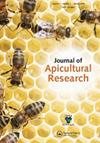The effect of migratory beekeeping on Indian honey bee ( Apis cerana indica ) microbiota – a first report
IF 1.8
4区 农林科学
Q2 ENTOMOLOGY
引用次数: 0
Abstract
AbstractMigratory beekeeping is a widely extended practice aimed at increasing the yield of honey and pollination services. Microbial symbionts that inhabit the honey bee’s gut are essential to their host’s food digestion, immunity, and gut protection. Throughout the honey bee life cycle and at several migratory sites, the taxonomic composition of the gut microbiota changes. However, it is yet unknown how significant changes in migratory locations, such as altered floral supply, parasitism and pathogen infestation, affect the dynamics of the gut microbiota. The goal of this study was to describe the Indian honey bee (Apis cerana indica) gut microbiome at different migratory sites of Puducherry and Tamil Nadu. Our results found that the core bacterial composition of the microbiota was consistent over different migratory sites. Despite this stability, our comparisons of the microbiota of honey bees from the same colony show that there are differences in composition at different migratory sites. Likewise, there is variation in relative abundance between microbiomes of different migratory sites. The four most dominant phyla were Proteobacteria followed by Bacteroidota, Actinobacteriota and Firmicutes. Most of the isolates belonged to families of Xanthomonadaceae, Orbaceae, Weeksellaceae, Bifidobacteriaceae, Rhizobiaceae, Neisseriaceae, Lactobacillaceae, Dysgonomonadaceae, Clostridiaceae and Enterococcaceae. However, several commensal bacteria that proliferate in the hive environment including members of Lactobacillaceae (Lactobacillus kunkeei), Bifidobacteriaceae, Orbaceae and Neisseriaceae were also identified and considered as beneficial gut inhabitants and involved in the maintenance of a healthy microbiota. This is the first report on bee gut microbiota from Puducherry and Tamil Nadu geographically situated at the southeast coast of India.Keywords: Apis cerana indicamigratory beekeepinggut microbiotacommensal bacteriasocial immunity AcknowledgementsThe authors would like to thank TANSCHE, for the project entitled “Development of Sericulture and Apiculture – a viable remunerative approach for the sustainable livelihood of coastal farmers, rural youth and women” as well as the Qbiogen, Chennai for their next-generation sequencing expertise. The authors also wish to thank the farmers and Aurobindo farm for providing their field to conduct the experiments and help during the transport of the hives.Disclosure statementNo potential conflict of interest was reported by the authors.Additional informationFundingThis work was supported by the Syngenta Private Ltd., Coimbatore [Grant No. 600-O-635].迁徙养蜂对印度蜜蜂(Apis cerana indica)微生物群的影响——首次报道
摘要:迁徙养蜂是一种广泛推广的做法,旨在提高蜂蜜产量和授粉服务。栖息在蜜蜂肠道中的共生微生物对宿主的食物消化、免疫和肠道保护至关重要。在整个蜜蜂生命周期和几个迁徙地点,肠道微生物群的分类组成发生了变化。然而,目前尚不清楚迁徙地点的重大变化,如植物供应、寄生和病原体感染的改变,如何影响肠道微生物群的动态。本研究的目的是描述印度蜜蜂(Apis cerana indica)在普杜切里和泰米尔纳德邦不同迁徙地点的肠道微生物群。我们的研究结果发现,微生物群的核心细菌组成在不同的迁移地点是一致的。尽管这种稳定性,我们对来自同一群体的蜜蜂的微生物群的比较表明,在不同的迁徙地点,微生物群的组成存在差异。同样,不同迁移地点的微生物群的相对丰度也存在差异。4个最占优势的门是变形菌门,其次是拟杆菌门、放线菌门和厚壁菌门。大部分分离物属于黄病菌科、orbacae科、weeksellacae科、双歧杆菌科、根瘤菌科、奈瑟菌科、乳酸杆菌科、Dysgonomonadaceae、梭菌科和肠球菌科。然而,在蜂箱环境中增殖的几种共生细菌,包括乳杆菌科(乳杆菌)、双歧杆菌科、Orbaceae和奈瑟菌科的成员,也被确定为有益的肠道居民,并参与维持健康的微生物群。这是关于位于印度东南海岸的普杜切里和泰米尔纳德邦的蜜蜂肠道微生物群的第一份报告。作者要感谢TANSCHE的“蚕桑和蜂业的发展——沿海农民、农村青年和妇女可持续生计的可行的有利可图的方法”项目,以及钦奈Qbiogen的下一代测序专业知识。作者还希望感谢农民和Aurobindo农场提供他们的场地进行实验,并在蜂箱运输过程中提供帮助。披露声明作者未报告潜在的利益冲突。本研究得到了哥印拜陀先正达私人有限公司[批准号600-O-635]的支持。
本文章由计算机程序翻译,如有差异,请以英文原文为准。
求助全文
约1分钟内获得全文
求助全文
来源期刊
CiteScore
4.80
自引率
10.50%
发文量
111
审稿时长
6-12 weeks
期刊介绍:
The Journal of Apicultural Research is a refereed scientific journal dedicated to bringing the best research on bees. The Journal of Apicultural Research publishes original research articles, original theoretical papers, notes, comments and authoritative reviews on scientific aspects of the biology, ecology, natural history, conservation and culture of all types of bee (superfamily Apoidea).

 求助内容:
求助内容: 应助结果提醒方式:
应助结果提醒方式:


